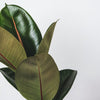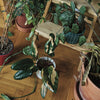The healing power of Aloe vera - Where does it come from and how to care for it?

Aloe vera , also known as "true aloe " , is one of the oldest and most recognized medicinal plants and one of the most popular plants in our homes.
This succulent plant stands out for its fleshy, green leaves and unique healing properties. It is considered a miracle of nature. Let's take a look at why you should buy Aloe.
Aloe vera has been used for thousands of years in many ancient civilizations, from ancient Egypt to Greece, for its ability to heal, hydrate and regenerate the skin . Today, Aloe vera is an indispensable part of many beauty and health products, offering a wide range of health benefits. In our article, we will focus on Aloe vera, from its botanical description, historical significance, through medicinal properties, to modern use and cultivation.
Aloe vera, botanically known as Aloe barbadensis miller , is a member of the Asphodelaceae family. It can survive in drought for a relatively long period and at the same time it is able to store water in its leaves, stems or roots . The plant is characterized by thick, fleshy leaves that grow directly from the ground. These leaves are usually green, sometimes with a reddish tinge, and can reach a length of up to 30-50 cm, in the wild they can grow to unexpected dimensions. The surface of the leaves is smooth, but there are often small thorns on their edges. Beware of them, although Aloe vera seems harmless, the thorns can cut you.
Aloe vera leaves contain three layers: a protective cuticle on the outside, a middle layer composed of gel-like mesophyll, and an inner set of fibers known as latex. The gel mesophyll is the main source of Aloe vera's medicinal properties and is rich in vitamins, minerals, amino acids and antioxidants.
History
The origin of Aloe vera is most often located in the Arabian Peninsula, but thanks to its high adaptability, today the plant is cultivated all over the world, especially in warm and dry regions. Aloe vera's flowering is also remarkable - the plant produces yellow or orange flowers on tall stalks that appear in the summer months. After flowering, the flowers dry up and either fall off by themselves or you can remove them mechanically.
Aloe vera has a rich history of use in many ancient civilizations, which testifies to its universal use as a medicinal plant. In ancient Egypt, Aloe vera was known as the "plant of immortality" and was commonly used for medicinal purposes, especially in embalming and skin care. The Egyptians recorded its use on papyrus scrolls, where it was described as a remedy for various skin diseases and as part of beauty rituals.
In ancient China and India, Aloe vera was also highly valued for its medicinal properties. In Ayurveda, it has been used to treat wounds, digestive problems and to improve general vitality. The Greeks and Romans used Aloe vera for its healing powers, and it was even mentioned by Hippocrates, the father of Western medicine, in his medical texts.
During the Middle Ages, Aloe vera spread to Europe and then to the New World with the Spanish and Portuguese colonizers. In many cultures, the plant was considered a symbol of protection and good luck, and was often placed on the doors of homes as protection against evil.
Modern use
Nowadays, Aloe vera is widely used in many industries, from cosmetics to the pharmaceutical industry.
Aloe vera is a basic ingredient of many cosmetic products. Due to its moisturizing and soothing properties, it is a common ingredient in skin care products such as creams, gels and shampoos . It is also known for its anti-inflammatory and antibacterial properties, making it a popular choice for products designed for sensitive or damaged skin.
Aloe vera has become a popular supplement in the healthcare industry. It is used for the treatment of minor burns, cuts, sunburns and other skin irritations. Aloe vera gel is also useful in treating conditions such as psoriasis or acne. Some studies indicate that it has beneficial effects, for example, in the treatment of digestive problems and strengthening the immune system. Aloe vera is widely recognized for its soothing and healing effects on the skin. The gel contained in Aloe vera leaves contains ingredients such as aloin and acemannan that help reduce inflammation and promote wound healing. This is why Aloe vera is often used to treat burns, cuts, sunburns and other skin irritations.
In some cultures, Aloe vera is also used in the food industry, either as a drink or as a food additive. Aloe vera juice is known for its hydrating and detoxifying properties and is becoming a popular ingredient in healthy drinks and smoothies.
Many people grow Aloe vera at home for immediate access to its healing properties. Simply cutting off a leaf and applying the gel directly to the skin is a common home treatment for minor burns and skin irritations.

Some studies suggest that Aloe vera can help boost the immune system due to its rich content of antioxidants and polysaccharides.
And now to the plant itself and how to take care of it, so that one day you too can make your own ointment or face mask.
How to care for Aloe Vera?
The plant prefers plenty of light, so it is ideal to place it in a sunny location. However, it can also tolerate partial shade. Water it sparingly and always let the substrate dry thoroughly between waterings. This plant is drought tolerant and excess water can cause root rot. Aloe vera can be propagated by offshoots or cuttings. Offshoots can be separated from the mother plant and transplanted into a new substrate.
What often bothers her?
Dried or brown leaves indicate a lack of light or direct sunlight. Move the plant to a brighter location. Broken or damaged leaves indicate that you are watering the plant with too hard water Water the aloe vera with soft water and minimize handling of the plant.
The most ideal substrate for Aloe vera is our substrate for succulents .
We keep our fingers crossed for you with Aloe Vera care. We believe that it is one of the plants that absolutely everyone can handle.
-
Posted in
Péče o pokojovky






